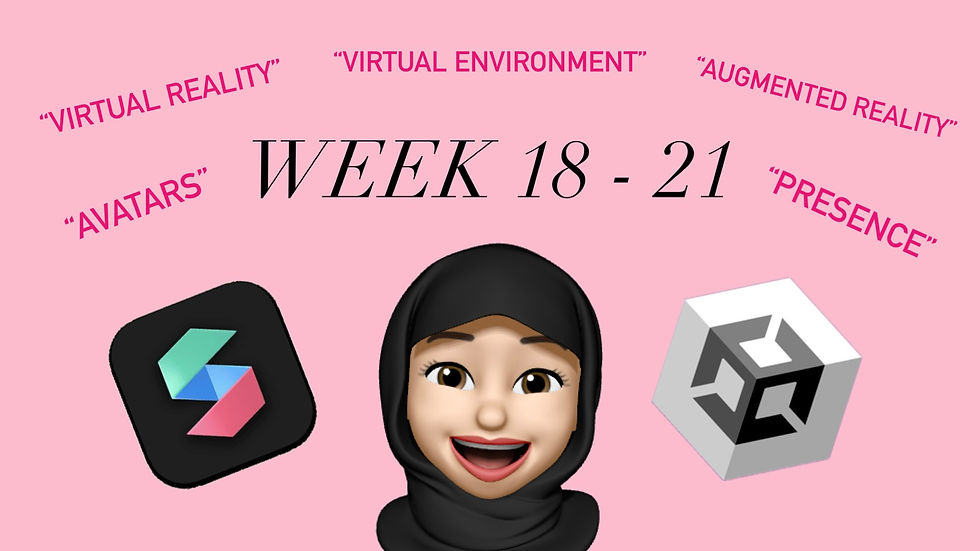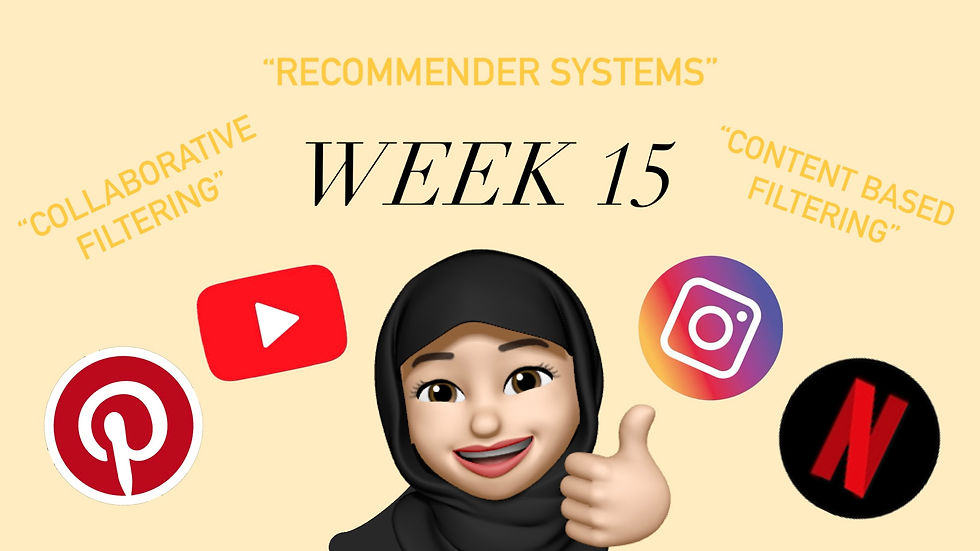Week 18 - 21: VR & AR
- Lami'ah Nosarka

- Apr 17, 2024
- 3 min read
Updated: Apr 23, 2024

28/02/2024 - 20/03/2024
During these two weeks we focused on #VirtualReality and #AugmentedReality. We covered the following topics; Intro to VR and AR, Virtual Environments, Avatars, Presence, Place and Plausibility Illusions
What is Virtual Reality?
VR is a technology that uses computer-generated immersive environments for exploration and interaction. It has advanced over the years and has managed to infiltrate into many areas such as healthcare, gaming and even learning!
What is a Virtual Environment?
A virtual environment is a simulated space created by computers that mimics real-world or fantasy settings. Users can fully immerse themselves into these environments by using a variety of different gear components which add to the realism of such settings.
Presence - The Illusion of Being There
Presence in VR refers to the feeling of truly being inside a virtual environment.
Place illusion = feeling of being in that place
Plausibility illusion = feeling that the specific event is reality when knowing that it is not real.
Break in presence = An action or multiple actions that can cause the realism of VR to be interrupted.
Avatars = digital 3D characters used to represent one's self virtually. Users can design avatars to resemble themselves precisely or customise them to resemble all types of different creatures.
Commercial Presence
VR has taken over various factors of the technology industry. A few corporations that have been integrating VR for public use are Meta, Google, Apple, Microsoft, Samsung.
Metaverse: Who's building is? What's the point?
The Metaverse is virtual platform on which users can socialise, work, play and interact with each other. It is said to be developed by a large number of companies. The point of the Metaverse is to provide users with access to a metaphorical version of the real world to be used and explored by their avatars or virtual selves.
Display Systems and Body Tracking Systems
HMD (Head-worn display):
head gear worn by users to provide an immersive experience.
includes vision, sound and head tracking motion sensors.
CAVE:
Room-sized cube projecting stereo images.
Used in conjunction with HMD head-tracking technology to continuously adjust the stereo projection to the current position of the leading viewer.
Body tracking systems:
Optical and inertial tracking setups.
Monitors body movements using either optical or inertial technology for realistic experiences.
Application of VR
VR has maintained its presence across a variety of industries other than Technology. A few of examples of VR applications can be found in the following industries:
Health care (socially, physically and mentally)
Sporting
Gaming
Education
Entertainment
Art
Activity1_VR_Training
Benefits of VR for trainings:
Safety: training can be carried out in a safe way by simulating dangerous situations
Self-paced: trainees can work through training material in their own time with minimal attention required from trainers.
Precision: VR technologies (body tracking) can be used to detect whether trainees are performing correctly and provide detailed feedback per trainee.
Disadvantages:
Costly: Top-range VR hardware can be expensive to implement on a large scale
Time consuming: for developers to create training scenarios
What is Augmented Reality?
AR is a technology which overlays digital information onto the real world which can enhance the user's interaction with their environment. It does so by blending reality with technology which is achieved using devices like smartphones or AR glasses. This, in turn, enhances how we see and interact with our surroundings.
My favourite type of AR technology is the type that allows users to try on fashion items (such as shoes and accessories) using just their smartphones! In this way, users can easily decide whether or not to make a purchase without having to physically try on items in-store.
Challenge: AR Filter
I decided to create an MDX trivia filter for current or prospective students. The filter is a trivia game of 8 MDX facts that can be guessed by users by tilting their heads to the right or left in order to select their answer. At the end of the game, a score is displayed. To start the game, users are required to tap the screen (as seen by the prompt at the bottom of the screen).
References:



Comments